BMW X5 3.0I 2003 Owner's Manual
Manufacturer: BMW, Model Year: 2003, Model line: X5 3.0I, Model: BMW X5 3.0I 2003Pages: 183, PDF Size: 2.31 MB
Page 21 of 183
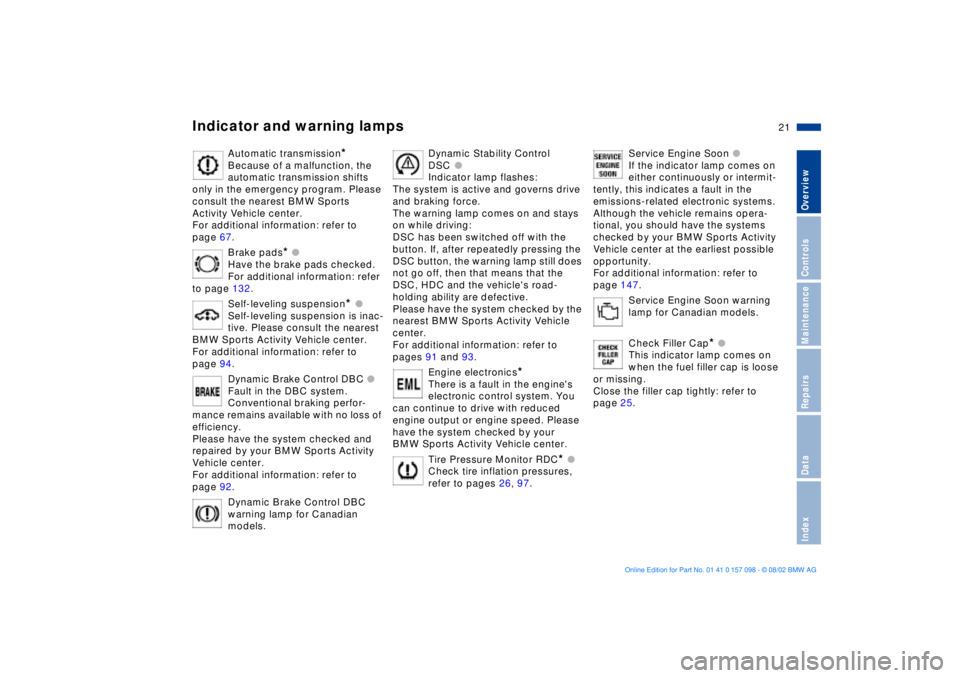
21n
OverviewControlsMaintenanceRepairsDataIndex
Indicator and warning lamps
Automatic transmission
*
Because of a malfunction, the
automatic transmission shifts
only in the emergency program. Please
consult the nearest BMW Sports
Activity Vehicle center.
For additional information: refer to
page 67.
Brake pads
*
l
Have the brake pads checked.
For additional information: refer
to page 132.
Self-leveling suspension
* l
Self-leveling suspension is inac-
tive. Please consult the nearest
BMW Sports Activity Vehicle center.
For additional information: refer to
page 94.
Dynamic Brake Control DBC l
Fault in the DBC system.
Conventional braking perfor-
mance remains available with no loss of
efficiency.
Please have the system checked and
repaired by your BMW Sports Activity
Vehicle center.
For additional information: refer to
page 92.
Dynamic Brake Control DBC
warning lamp for Canadian
models.
Dynamic Stability Control
DSC
l
Indicator lamp flashes:
The system is active and governs drive
and braking force.
The warning lamp comes on and stays
on while driving:
DSC has been switched off with the
button. If, after repeatedly pressing the
DSC button, the warning lamp still does
not go off, then that means that the
DSC, HDC and the vehicle's road-
holding ability are defective.
Please have the system checked by the
nearest BMW Sports Activity Vehicle
center.
For additional information: refer to
pages 91 and 93.
Engine electronics
*
There is a fault in the engine's
electronic control system. You
can continue to drive with reduced
engine output or engine speed. Please
have the system checked by your
BMW Sports Activity Vehicle center.
Tire Pressure Monitor RDC
* l
Check tire inflation pressures,
refer to pages 26, 97.
Service Engine Soon l
If the indicator lamp comes on
either continuously or intermit-
tently, this indicates a fault in the
emissions-related electronic systems.
Although the vehicle remains opera-
tional, you should have the systems
checked by your BMW Sports Activity
Vehicle center at the earliest possible
opportunity.
For additional information: refer to
page 147.
Service Engine Soon warning
lamp for Canadian models.
Check Filler Cap
* l
This indicator lamp comes on
when the fuel filler cap is loose
or missing.
Close the filler cap tightly: refer to
page 25.
Page 22 of 183
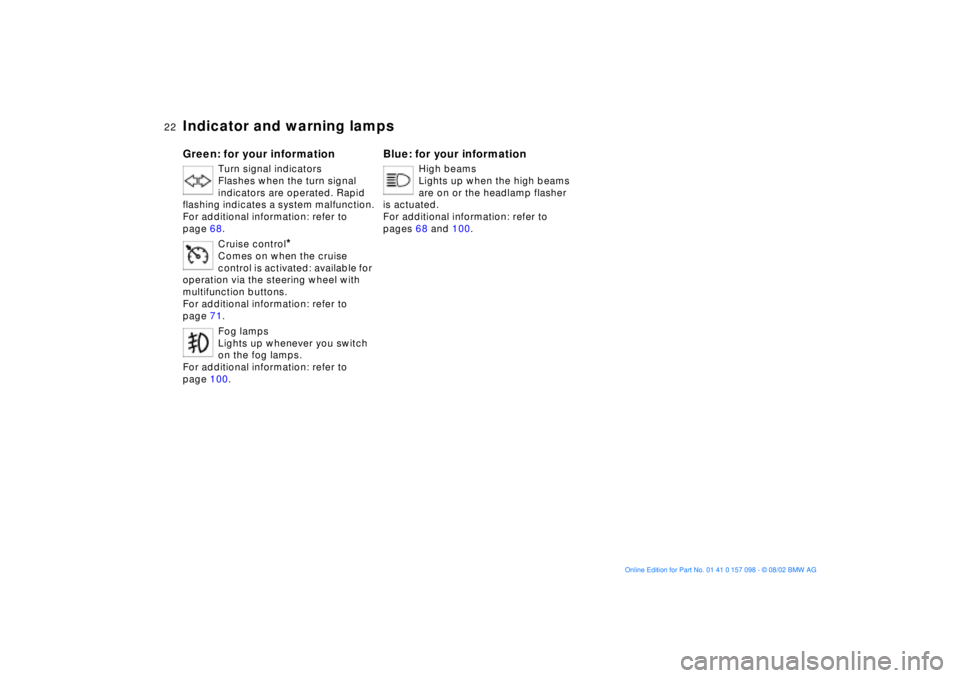
22n
Indicator and warning lamps Green: for your information
Turn signal indicators
Flashes when the turn signal
indicators are operated. Rapid
flashing indicates a system malfunction.
For additional information: refer to
page 68.
Cruise control
*
Comes on when the cruise
control is activated: available for
operation via the steering wheel with
multifunction buttons.
For additional information: refer to
page 71.
Fog lamps
Lights up whenever you switch
on the fog lamps.
For additional information: refer to
page 100.
Blue: for your information
High beams
Lights up when the high beams
are on or the headlamp flasher
is actuated.
For additional information: refer to
pages 68 and 100.
Page 23 of 183
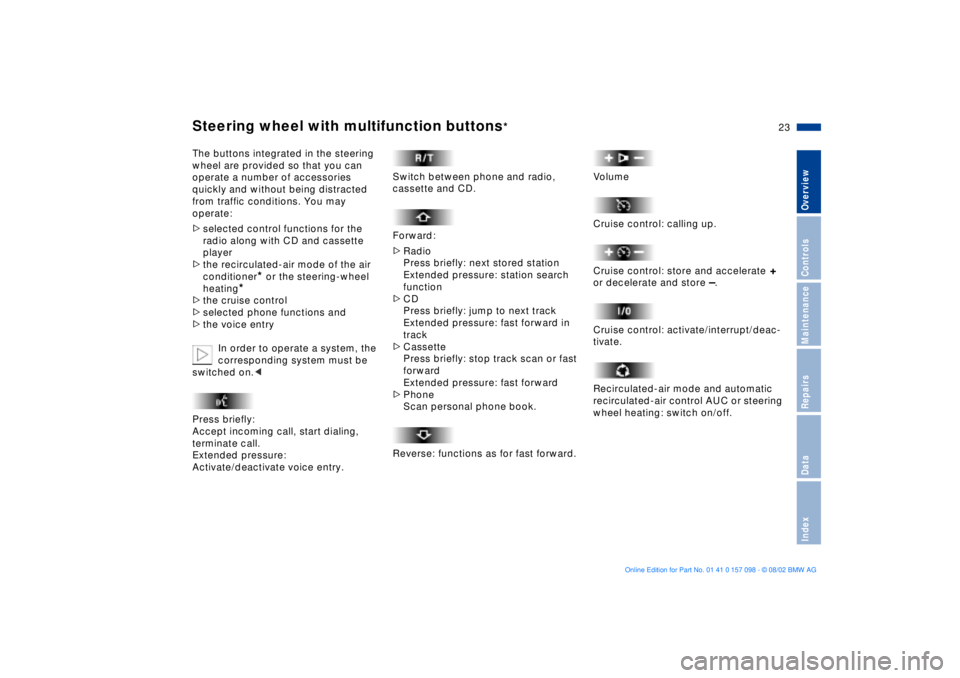
23n
OverviewControlsMaintenanceRepairsDataIndex
Steering wheel with multifunction buttons
*
The buttons integrated in the steering
wheel are provided so that you can
operate a number of accessories
quickly and without being distracted
from traffic conditions. You may
operate:
>selected control functions for the
radio along with CD and cassette
player
>the recirculated-air mode of the air
conditioner
* or the steering-wheel
heating
*
>the cruise control
>selected phone functions and
>the voice entry
In order to operate a system, the
corresponding system must be
switched on.<
Press briefly:
Accept incoming call, start dialing,
terminate call.
Extended pressure:
Activate/deactivate voice entry.
Switch between phone and radio,
cassette and CD.
Forward:
>Radio
Press briefly: next stored station
Extended pressure: station search
function
>CD
Press briefly: jump to next track
Extended pressure: fast forward in
track
>Cassette
Press briefly: stop track scan or fast
forward
Extended pressure: fast forward
>Phone
Scan personal phone book.
Reverse: functions as for fast forward.
Volume
Cruise control: calling up.
Cruise control: store and accelerate
+
or decelerate and store
Ð.
Cruise control: activate/interrupt/deac-
tivate.
Recirculated-air mode and automatic
recirculated-air control AUC or steering
wheel heating: switch on/off.
Page 24 of 183
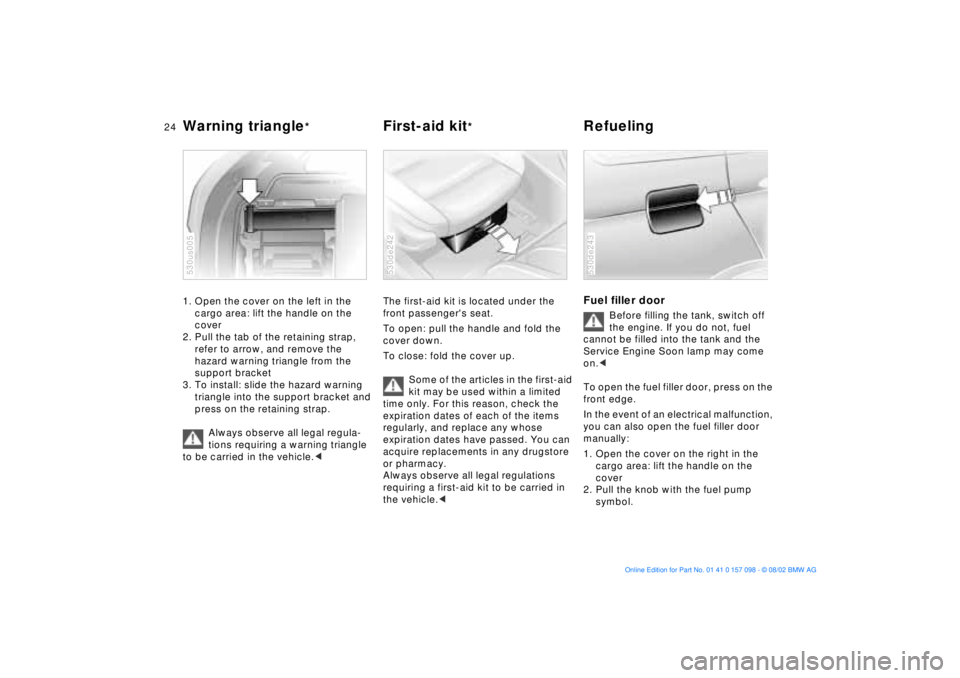
24n
Warning triangle
*
First-aid kit
*
Refueling
1. Open the cover on the left in the
cargo area: lift the handle on the
cover
2. Pull the tab of the retaining strap,
refer to arrow, and remove the
hazard warning triangle from the
support bracket
3. To install: slide the hazard warning
triangle into the support bracket and
press on the retaining strap.
Always observe all legal regula-
tions requiring a warning triangle
to be carried in the vehicle.< 530us005
The first-aid kit is located under the
front passenger's seat.
To open: pull the handle and fold the
cover down.
To close: fold the cover up.
Some of the articles in the first-aid
kit may be used within a limited
time only. For this reason, check the
expiration dates of each of the items
regularly, and replace any whose
expiration dates have passed. You can
acquire replacements in any drugstore
or pharmacy.
Always observe all legal regulations
requiring a first-aid kit to be carried in
the vehicle.< 530de242
Fuel filler door
Before filling the tank, switch off
the engine. If you do not, fuel
cannot be filled into the tank and the
Service Engine Soon lamp may come
on.<
To open the fuel filler door, press on the
front edge.
In the event of an electrical malfunction,
you can also open the fuel filler door
manually:
1. Open the cover on the right in the
cargo area: lift the handle on the
cover
2. Pull the knob with the fuel pump
symbol.
530de243
Page 25 of 183
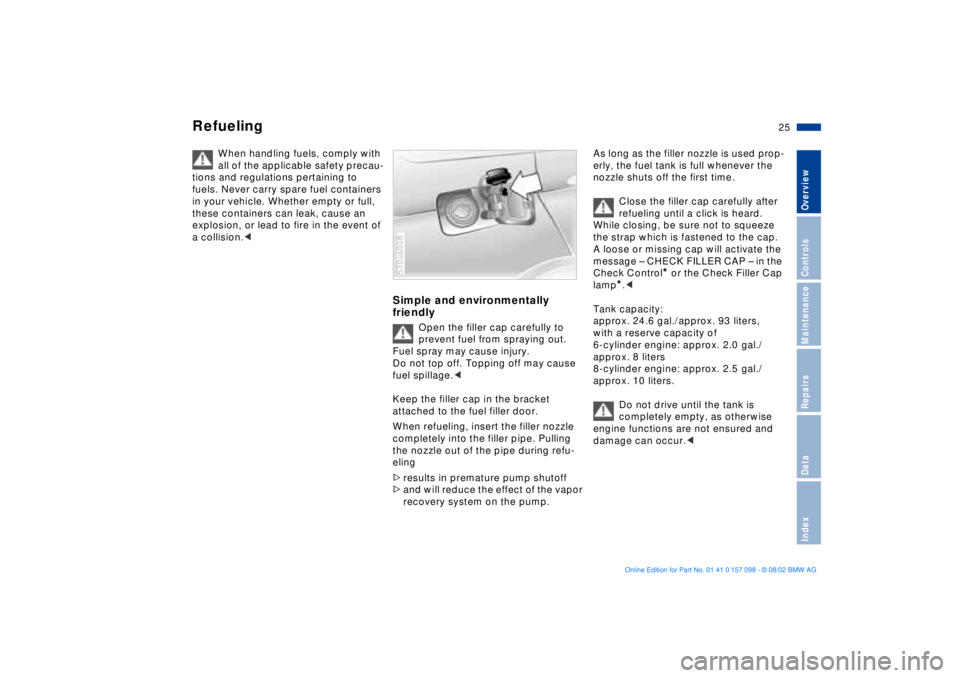
25n
OverviewControlsMaintenanceRepairsDataIndex
Refueling
When handling fuels, comply with
all of the applicable safety precau-
tions and regulations pertaining to
fuels. Never carry spare fuel containers
in your vehicle. Whether empty or full,
these containers can leak, cause an
explosion, or lead to fire in the event of
a collision.<
Simple and environmentally
friendly
Open the filler cap carefully to
prevent fuel from spraying out.
Fuel spray may cause injury.
Do not top off. Topping off may cause
fuel spillage.<
Keep the filler cap in the bracket
attached to the fuel filler door.
When refueling, insert the filler nozzle
completely into the filler pipe. Pulling
the nozzle out of the pipe during refu-
eling
>results in premature pump shutoff
>and will reduce the effect of the vapor
recovery system on the pump.
530us008
As long as the filler nozzle is used prop-
erly, the fuel tank is full whenever the
nozzle shuts off the first time.
Close the filler cap carefully after
refueling until a click is heard.
While closing, be sure not to squeeze
the strap which is fastened to the cap.
A loose or missing cap will activate the
message Ð CHECK FILLER CAP Ð in the
Check Control
* or the Check Filler Cap
lamp
*.<
Tank capacity:
approx. 24.6 gal./approx. 93 liters,
with a reserve capacity of
6-cylinder engine: approx. 2.0 gal./
approx. 8 liters
8-cylinder engine: approx. 2.5 gal./
approx. 10 liters.
Do not drive until the tank is
completely empty, as otherwise
engine functions are not ensured and
damage can occur.<
Page 26 of 183
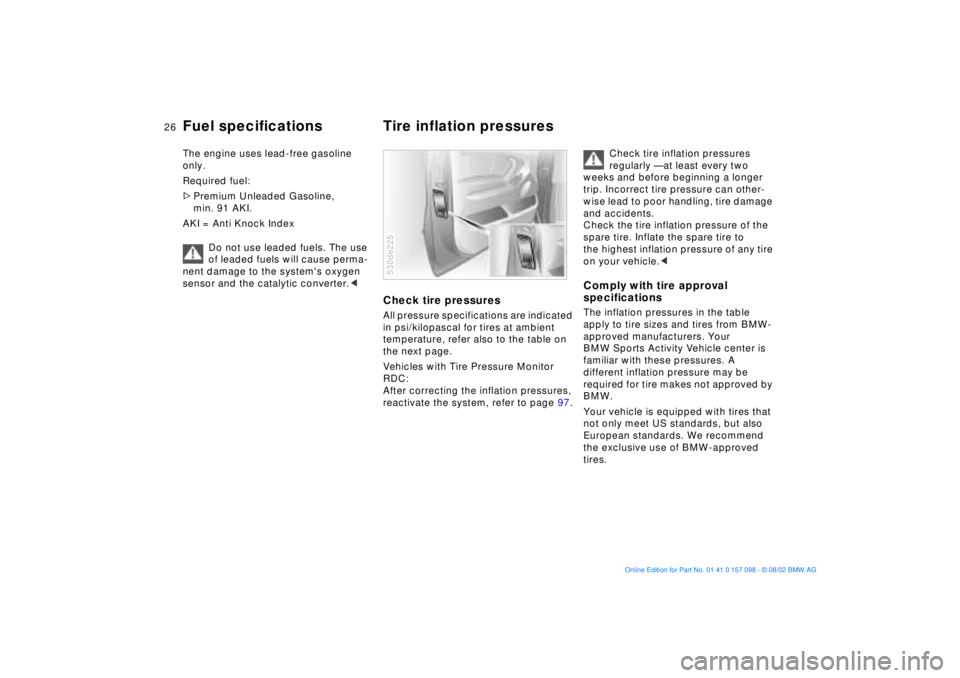
26n
Fuel specifications Tire inflation pressures The engine uses lead-free gasoline
only.
Required fuel:
>Premium Unleaded Gasoline,
min. 91 AKI.
AKI = Anti Knock Index
Do not use leaded fuels. The use
of leaded fuels will cause perma-
nent damage to the system's oxygen
sensor and the catalytic converter.<
Check tire pressures All pressure specifications are indicated
in psi/kilopascal for tires at ambient
temperature, refer also to the table on
the next page.
Vehicles with Tire Pressure Monitor
RDC:
After correcting the inflation pressures,
reactivate the system, refer to page 97.530de225
Check tire inflation pressures
regularly Ñ at least every two
weeks and before beginning a longer
trip. Incorrect tire pressure can other-
wise lead to poor handling, tire damage
and accidents.
Check the tire inflation pressure of the
spare tire. Inflate the spare tire to
the highest inflation pressure of any tire
on your vehicle.<
Comply with tire approval
specificationsThe inflation pressures in the table
apply to tire sizes and tires from BMW-
approved manufacturers. Your
BMW Sports Activity Vehicle center is
familiar with these pressures. A
different inflation pressure may be
required for tire makes not approved by
BMW.
Your vehicle is equipped with tires that
not only meet US standards, but also
European standards. We recommend
the exclusive use of BMW-approved
tires.
Page 27 of 183
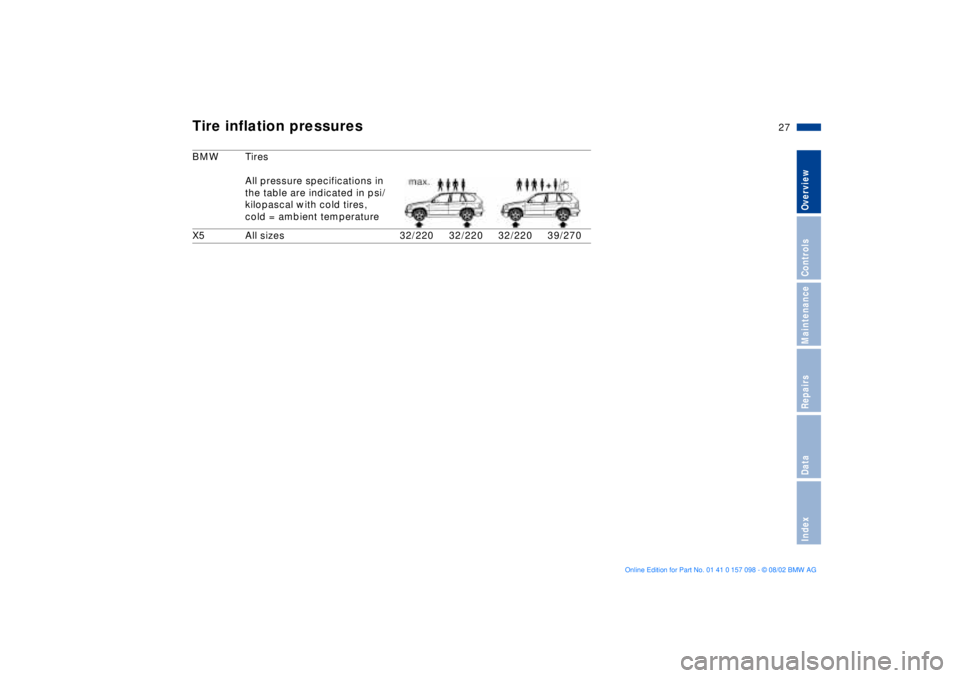
27n
OverviewControlsMaintenanceRepairsDataIndex
Tire inflation pressures BMW Tires
All pressure specifications in
the table are indicated in psi/
kilopascal with cold tires,
cold = ambient temperature
X5 All sizes 32/220 32/220 32/220 39/270
Page 28 of 183
28n
Controls
Page 29 of 183
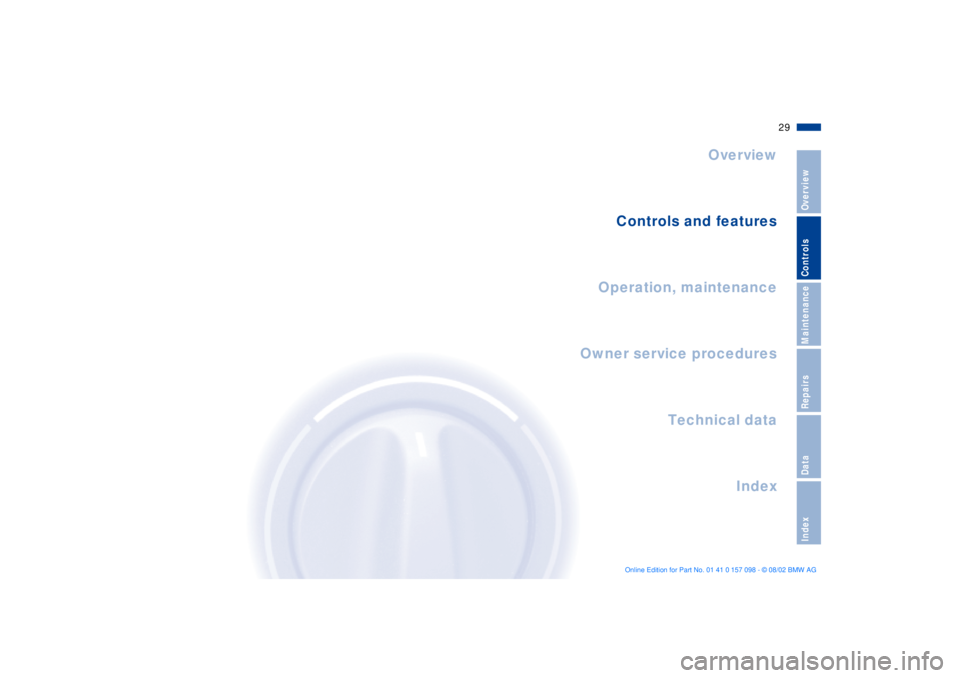
29n
OverviewControlsMaintenanceRepairsDataIndex
Overview
Controls and features
Operation, maintenance
Index Technical data
Owner service procedures
Page 30 of 183
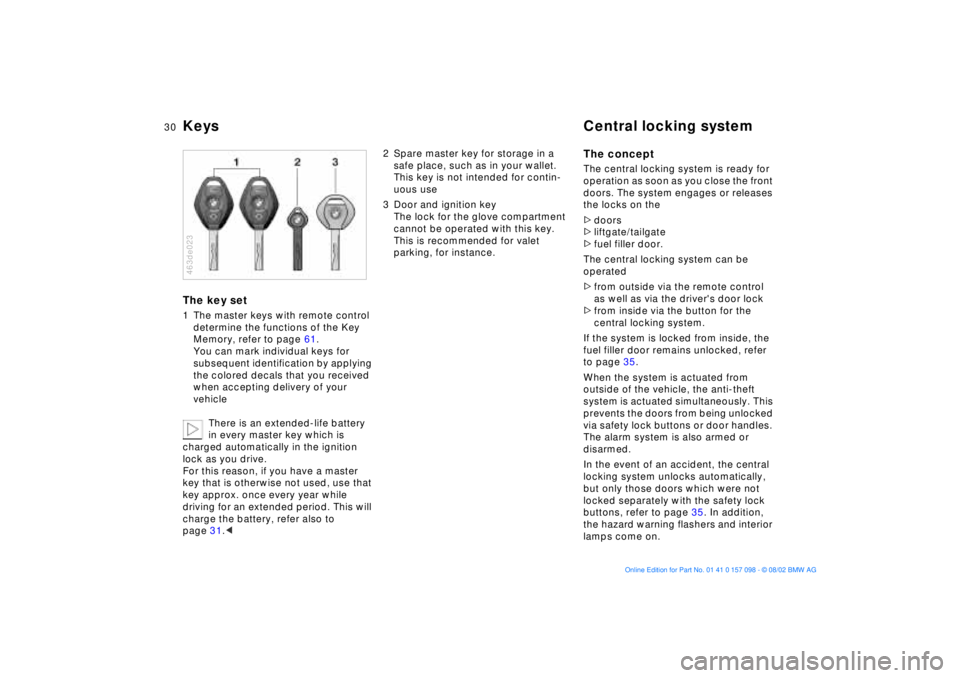
30n
Keys Central locking system The key set1 The master keys with remote control
determine the functions of the Key
Memory, refer to page 61.
You can mark individual keys for
subsequent identification by applying
the colored decals that you received
when accepting delivery of your
vehicle
There is an extended-life battery
in every master key which is
charged automatically in the ignition
lock as you drive.
For this reason, if you have a master
key that is otherwise not used, use that
key approx. once every year while
driving for an extended period. This will
charge the battery, refer also to
page 31.< 463de023
2 Spare master key for storage in a
safe place, such as in your wallet.
This key is not intended for contin-
uous use
3 Door and ignition key
The lock for the glove compartment
cannot be operated with this key.
This is recommended for valet
parking, for instance.
The concept The central locking system is ready for
operation as soon as you close the front
doors. The system engages or releases
the locks on the
>doors
>liftgate/tailgate
>fuel filler door.
The central locking system can be
operated
>from outside via the remote control
as well as via the driver's door lock
>from inside via the button for the
central locking system.
If the system is locked from inside, the
fuel filler door remains unlocked, refer
to page 35.
When the system is actuated from
outside of the vehicle, the anti-theft
system is actuated simultaneously. This
prevents the doors from being unlocked
via safety lock buttons or door handles.
The alarm system is also armed or
disarmed.
In the event of an accident, the central
locking system unlocks automatically,
but only those doors which were not
locked separately with the safety lock
buttons, refer to page 35. In addition,
the hazard warning flashers and interior
lamps come on.